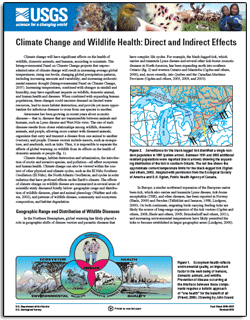Fact Sheet 2010-3017

Climate change will have significant effects on the health of wildlife, domestic animals, and humans, according to scientists. The Intergovernmental Panel on Climate Change projects that unprecedented rates of climate change will result in increasing average global temperatures; rising sea levels; changing global precipitation patterns, including increasing amounts and variability; and increasing midcontinental summer drought (Intergovernmental Panel on Climate Change, 2007). Increasing temperatures, combined with changes in rainfall and humidity, may have significant impacts on wildlife, domestic animal, and human health and diseases. When combined with expanding human populations, these changes could increase demand on limited water resources, lead to more habitat destruction, and provide yet more opportunities for infectious diseases to cross from one species to another. Awareness has been growing in recent years about zoonotic diseases— that is, diseases that are transmissible between animals and humans, such as Lyme disease and West Nile virus. The rise of such diseases results from closer relationships among wildlife, domestic animals, and people, allowing more contact with diseased animals, organisms that carry and transmit a disease from one animal to another (vectors), and people. Disease vectors include insects, such as mosquitoes, and arachnids, such as ticks. Thus, it is impossible to separate the effects of global warming on wildlife from its effects on the health of domestic animals or people. Climate change, habitat destruction and urbanization, the introduction of exotic and invasive species, and pollution—all affect ecosystem and human health. Climate change can also be viewed within the context of other physical and climate cycles, such as the El Niño Southern Oscillation (El Niño), the North Atlantic Oscillation, and cycles in solar radiation that have profound effects on the Earth’s climate. The effects of climate change on wildlife disease are summarized in several areas of scientific study discussed briefly below: geographic range and distribution of wildlife diseases, plant and animal phenology (Walther and others, 2002), and patterns of wildlife disease, community and ecosystem composition, and habitat degradation. |
First Posted March 2010 For additional information contact: Part or all of this report is presented in Portable Document Format (PDF); the latest version of Adobe Reader or similar software is required to view it. Download the latest version of Adobe Reader, free of charge. |
Hofmeister, Erik, Moede Rogall, Gail, Wesenberg, Kathy, Abbott, Rachel, Work, Thierry, Schuler, Krysten, Sleeman, Jonanthan, and Winton, James, 2010, Climate change and wildlife health: Direct and indirect effects: U.S. Geological Survey Fact Sheet 2010–3017, 4 p.
Geographic Range and Distribution of Wildlife Diseases
Phenology: Effects on Wildlife Disease
Changing Patterns of Wildlife Disease
Community and Ecosystem Changes
Habitat Alteration
Questions to Ponder about Climate Change
References